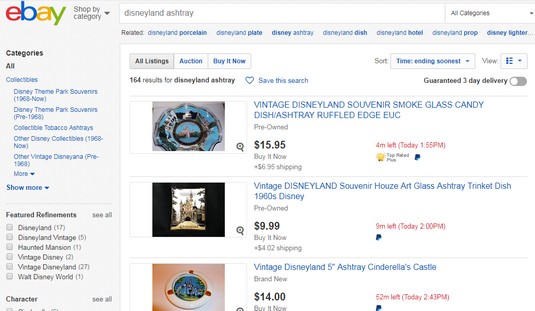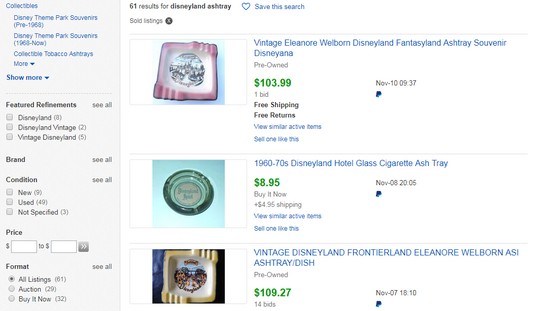Understanding eBay’s grading terms
One of the keys to establishing value is knowing an item’s condition, typically referred to as an item’s grade. The following table lists the most common grading categories that collectors use. The information in this table is used with permission from (and appreciation to) Lee Bernstein.| Category (Also Known As) | What It Means | Example |
| Mint (M, Fine, Mint-In-Box [MIB], 10) | A never-used collectible in perfect condition with complete packaging (including instructions, original attachments, tags, and so on) identical to how it appeared on the shelf in the original box. | Grandma got a soup tureen as a wedding present, never opened it, and stuck it in her closet for the next 50 years. |
| Near Mint (NM, Near Fine, Like-New, 9) | The collectible is perfect but no longer has the original packaging or the original packaging is less than perfect. Possibly used but must appear to be new. | Grandma used the soup tureen on her 25th anniversary, washed it gently, and then put it back in the closet. |
| Excellent (EX, 8) | Used, but barely. Excellent is just a small step under Near Mint, and many sellers mistakenly interchange the two, but Excellent can have very minor signs of wear. The wear must be a normal, desirable part of aging or so minor that it’s barely noticeable and visible only upon close inspection. Damage of any sort is not “very minor.” Wear or minor, normal factory flaws should be noted. (Factory flaws are small blemishes common at the time of manufacture — a tiny air bubble under paint, for example.) | Grandma liked to ring in the New Year with a cup of soup for everyone. |
| Very Good (VG, 7) | Looks very good but has defects, such as a minor chip or light color fading. | If you weren’t looking for it, you might miss that Grandma’s tureen survived the ’64 earthquake, as well as Uncle Bob’s infamous ladle episode. |
| Good (G, 6) | Used with defects. More than a small amount of color loss, chips, cracks, tears, dents, abrasions, missing parts, and so on. | Grandma had the ladies in the neighborhood over for soup and bingo every month. |
| Poor (P or G-, 5) | Barely collectible, if at all. Severe damage or heavy use. Beyond repair. | Grandma ran a soup kitchen. |
How can you compete? Well, in addition to having a well-planned bidding strategy, knowing your stuff gives you a winning edge.
The values of collectibles go up and down. Star Wars items are a perfect example. Values skyrocket during the release of the latest movie, but then settle to a considerably lower level. Any published book of value listings is valid only for the moment the book is written. If you stay on top of your market in a few specialties, you’ll be aware of these market fluctuations. If you’re looking for the highest price for Star Wars items, for example, instead of looking to liquidate excess inventory, hold those items until they hit the pop culture charts again.
Determining the “going price” of a particular item on eBay is as simple as performing a Completed Items search. Let’s check out what a few vintage (mint) ashtrays from Disneyland go for on eBay:- Type in the keywords in the Search text box at the top of every page and click the Search button.
The resulting page shows you how many items that match your keywords are being sold on eBay at that moment. If you get too many results, add an extra keyword that further defines your item and repeat the search. This search garnered 164 active listings.
 One hundred sixty four listings matching “Disneyland Ashtray” up for sale.
One hundred sixty four listings matching “Disneyland Ashtray” up for sale. - Scroll down the page and look at the images of items for sale, making note of which ones actually match your item.
From here, you get an idea of the prices that sellers are asking.
- In the column on the left, under Show Only, choose an option. They are
- Sold Listings: Shows you only the items that actually sold. To get an idea of the highest price you can get for the item, use the sort option at the top of the page by selecting Price: Highest First from the Sort drop-down menu. What an eye-opener! These results show you exactly which variations of your item were the most valuable — and which keywords work the best to attract customer’s eyes.
 Sort search results for Sold listings with highest prices first.
Sort search results for Sold listings with highest prices first. - Completed Listings: Clicking this option shows you how many listings have run their course and are over. If the item sold, the final price is indicated in green text. If the item hasn’t sold, you see the final price in red. By studying this data, you can get an idea of a good starting price to set for your item to encourage sales and higher bids.
- Sold Listings: Shows you only the items that actually sold. To get an idea of the highest price you can get for the item, use the sort option at the top of the page by selecting Price: Highest First from the Sort drop-down menu. What an eye-opener! These results show you exactly which variations of your item were the most valuable — and which keywords work the best to attract customer’s eyes.
- For the deepest research, click the individual items that garnered the highest prices and see how the seller described the item.
Smart sellers tell the stories behind collectibles and add appropriate keywords to their titles!
During this search, there were listings for the same item that sold from $7.99 up to $103! Why? First it depends on the style and year of issue. Next, the sellers who received the lowest final sale prices put their items up for sale when several others were selling the same item. eBay is a supply-and-demand venue. Even if an item is rare, the final sale price will go down if there are too many up for sale.

